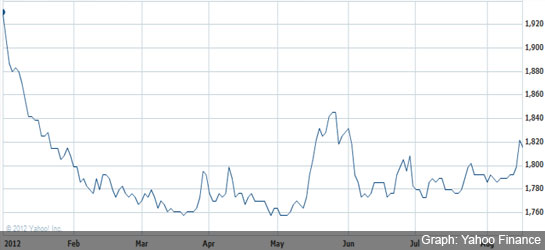
The Colombian peso, which had been on a tear for much of the year, has retreated against the dollar in recent days, slammed by the global decline in commodity prices and the government’s $1.2 billion dollar-purchase plan.
The peso’s weakness mirrors the decline of late in other Latin American currencies, which have retreated on lower prices for commodities that represent their main source of foreign income.
“There’s growing risk aversion and investors are pulling out of these currencies,” said Francisco Chaves, a research analyst with brokerage firm Corredores Asociados. Colombia’s export receipts continue to be dominated by oil and coal.
The exchange rate impact of the retreat in commodity prices has been intensified by the government’s plan unveiled last month to buy $1.2 billion before the end of the year in the spot foreign exchange market. The money will be placed in a fund to pay off foreign debt coming due next year.
“The government has been very lucky with the timing of this announcement” because it coincided with the start of the drop in commodities, said Chaves. The dollar-buying plan along with growing risk aversion in international markets “are the factors behind the weaker peso,” he said.
Before the government announced its dollar-buying plan, the peso traded at COP1,768.00 to the dollar. On Tuesday, it traded at COP1,826.25. Some traders said the government has been making small dollar purchases in the spot market, although there’s no official data on how much it has bought yet.
The purchases bolster the impact of the central bank’s own dollar acquisitions in the spot market. The central bank so far this year has bought $1.62 billion as part of its pledge to buy a minimum of $20 million daily in the spot market in a bid to tame the peso’s strength against the dollar.
The weaker peso is likely a much welcome breather for President Juan Manuel Santos, who has faced growing pressure from exporters when the peso nears the COP1,750 mark. Still, other measures may be necessary to continue keeping a leash on the currency. Massive inflows of foreign direct investment, geared at the oil and mining sector, will likely continue to strength the peso and challenge the government.
Colombia has steered away from capital controls, which limit foreign investment, to deal with these massive inflows. “We expect that the central bank at some point will have to increase its dollar purchases,” said Po Jeng Ng, an analyst with brokerage firm Interbolsa SA.

